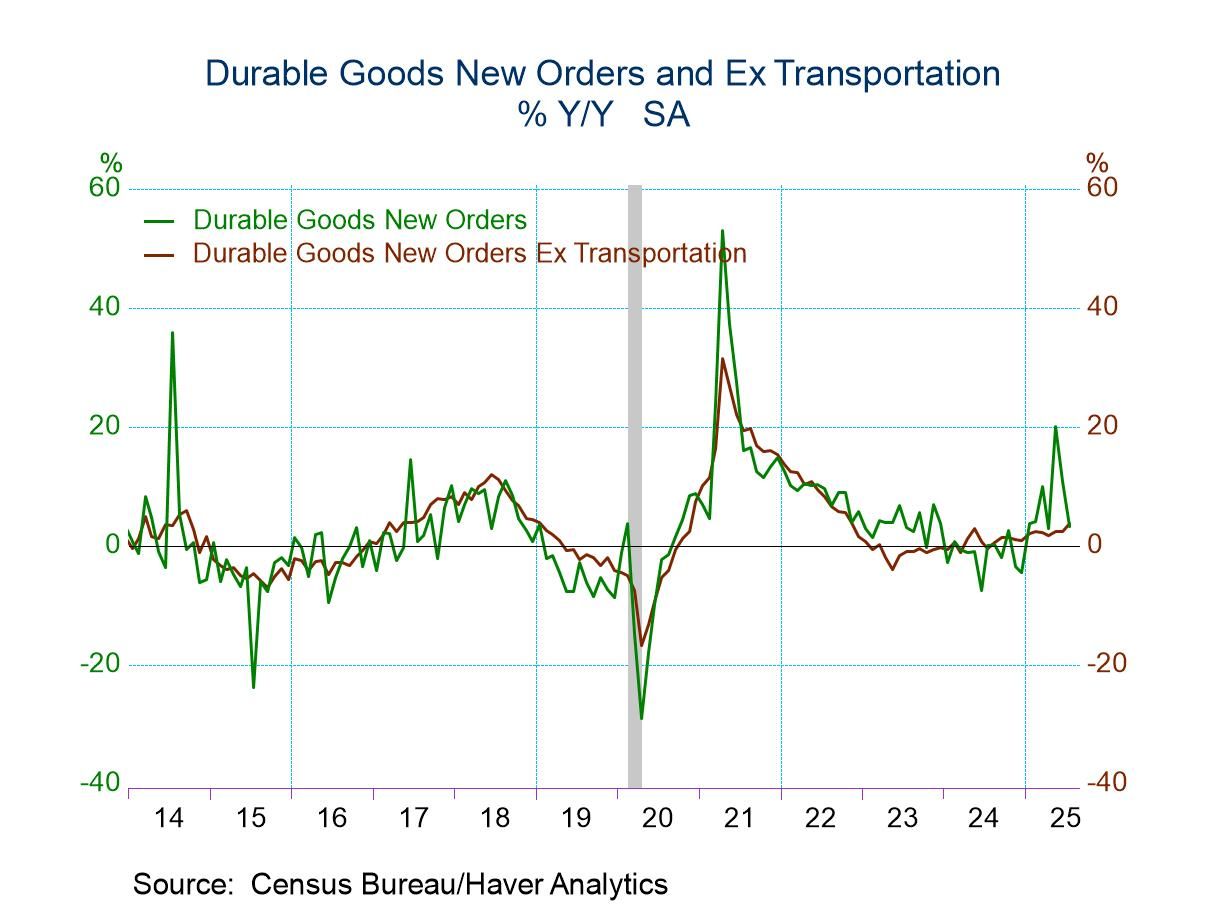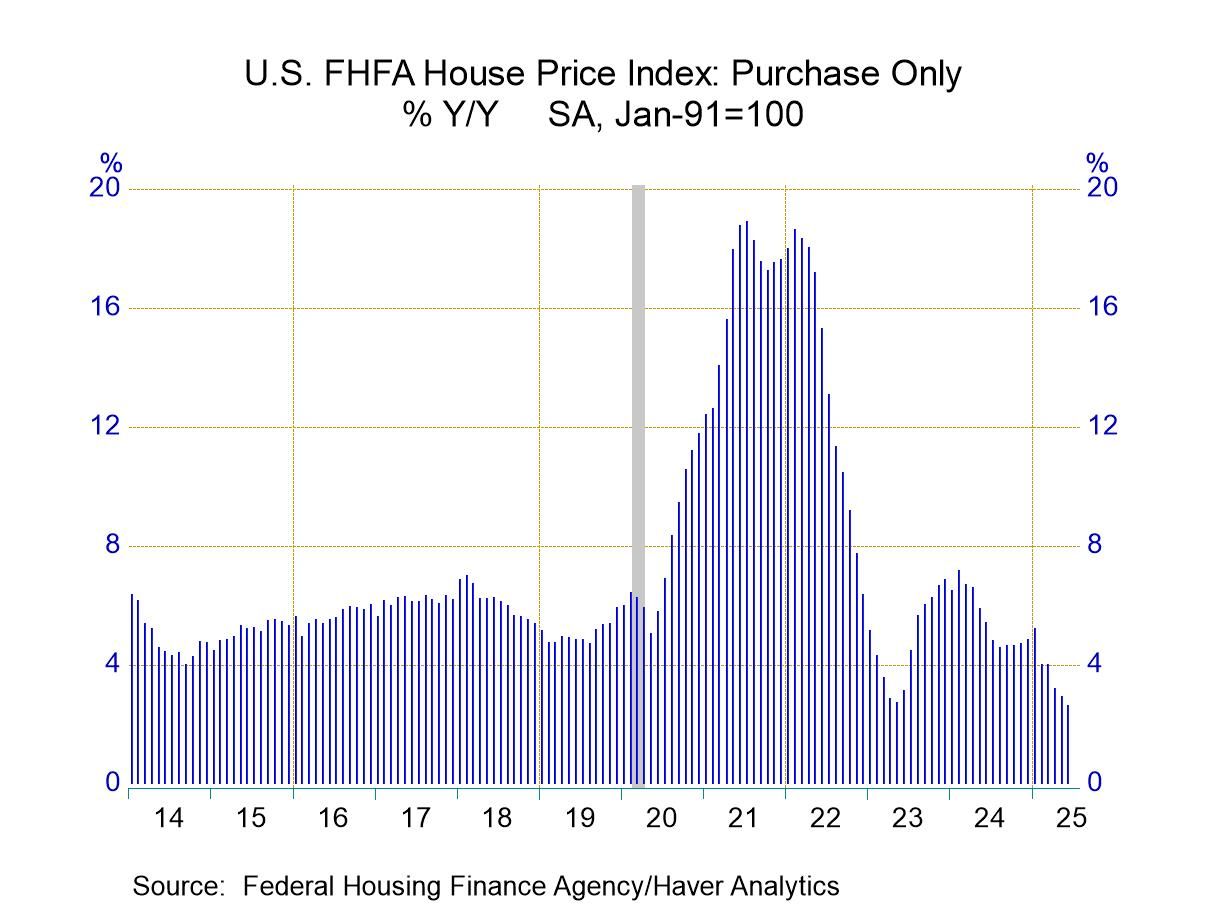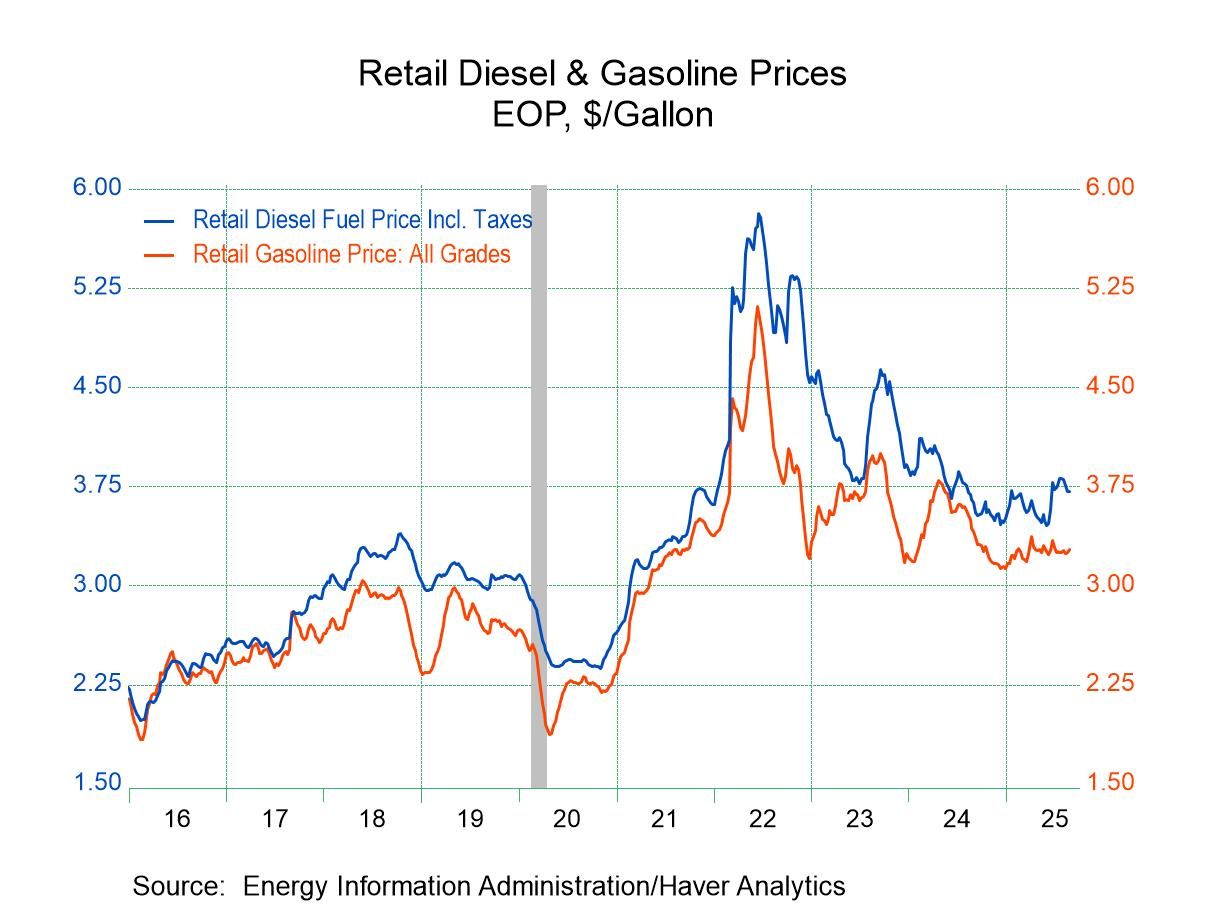 Global| Jan 07 2020
Global| Jan 07 2020U.S. Energy Product Prices Edge Higher
by:Tom Moeller
|in:Economy in Brief
Summary
etail gasoline prices inched up to $2.58 per gallon (15.2% y/y) last week from $2.57 per gallon in the previous week. Last week's price roughly equaled last year's average. Typically, gasoline prices weaken this time of year and Haver [...]
Retail gasoline prices
inched up to $2.58 per gallon (15.2% y/y) last week from $2.57 per gallon in the
previous week. Last week's price roughly equaled last year's average. Typically,
gasoline prices weaken this time of year and Haver Analytics adjusts prices for
seasonal variation. The seasonally adjusted gasoline price rose one cent to $2.76
per gallon, the highest price since mid-May.
In the week ended January 3, the West Texas Intermediate
crude oil price rose to $61.76 per barrel (32.2% y/y) from $61.28 per barrel
in the previous week. This is the highest price since mid-May. Yesterday, the
price was $63.27. Brent crude oil prices eased to an average of $66.68 per
barrel (+20.6% y/y) from $67.38 in the previous week. They rose yesterday to $68.87. The weekly average price of natural gas rose to $2.07/mmbtu
(-29.1% y/y) in the week ended January 3 after falling to an average of $2.03/mmbtu
in the previous week. Prices improved yesterday to $2.10. In the four-weeks ending December 27, gasoline demand
increased 0.8% y/y but total petroleum product demand declined 2.7% y/y. Gasoline
inventories gained 1.0% y/y and inventories of all petroleum products
increased 0.6% y/y. Crude oil input to refineries fell 3.6% y/y in the last four
weeks. These data are reported by the U.S. Department of Energy. The
price data can be found in Haver's WEEKLY and DAILY databases.
Greater detail on prices, as well as the demand, production and inventory data,
along with regional breakdowns, are in OILWKLY.
Weekly Energy Prices
01/06/20
12/30/19
12/23/19
Y/Y %
2019
2018
2017
Retail Gasoline ($ per Gallon Regular,
Monday Price, End of Period)
2.58
2.57
2.53
15.2
2.57
2.27
2.47
Light Sweet Crude Oil, WTI ($ per bbl,
Previous Week's Average)
61.76
61.28
60.73
32.2
56.91
64.95
50.87
Natural Gas ($/mmbtu, LA, Previous
Week's Average)
2.07
2.03
2.28
-29.1
2.57
3.18
2.99
U.S. Trade Deficit Narrows To Three-Year Low The U.S. trade deficit in goods and services declined to $43.09
billion during November from $46.90 in October, revised from $47.20 billion. It
was the smallest deficit since October 2016. A $43.9 billion deficit had been
expected in the Action Economics Forecast Survey. Exports improved 0.7% (0.3%
y/y) after a 0.1% dip while imports weakened 1.0% (-3.8% y/y) following two
months of even sharper decline. The trade deficit in goods fell to $63.00 billion in November
after a sharp reduction in October's deficit to $66.70 billion. It also was the
smallest deficit since October 2016. Imports of goods declined 1.4% (-5.7% y/y) as nonpetroleum
imports fell 1.2% (-4.8% y/y). Capital goods imports declined 2.0% (-3.7% y/y)
and nonauto consumer goods were off 1.9% (-4.5% y/y). Industrial materials
imports fell 1.5% (-12.1% y/y) and imports of foods, feeds & beverages
weakened 1.3% (+0.1% y/y). Countering these declines was a 3.7% rise (-5.9% y/y)
in automobile & parts imports. Petroleum imports declined 3.2% (-15.3% y/y)
as the price of crude oil per barrel eased to $51.92 (-9.8% y/y). Exports of goods rose 0.8% (-1.4% y/y), led by a 3.3%
increase (8.8% y/y) in automobile & parts exports. Nonauto consumer goods
exports increased 2.9% but were unchanged y/y. Foods, feeds and beverages
exports rose 1.8% (6.4% y/y) while capital goods exports strengthened 1.4%
(-5.8% y/y). Showing weakness last month, exports of industrial supplies &
materials eased 0.4% (-2.1% y/y). The surplus on trade in services was steady at $20.8 billion,
but remained below the March 2018 peak of $22.8 billion. The value of services
exports gained 0.5% (3.8% y/y). Tourism exports rose 0.3% (0.2% y/y). Charges
for intellectual property exports improved 0.4% (3.4% y/y). Imports of services
grew 0.8% (4.7% y/y). Tourism imports improved 1.2% (3.4% y/y) and intellectual
property imports rose 0.5% (2.5% y/y). The trade deficit with China narrowed to $25.6 billion (SA)
billion in November from $36.2 billion twelve months earlier. Exports to China
rose 18.8% (19.9% y/y). Imports fell 2.2% (-21.6% y/y). The trade deficit with
the European Union lessened to $13.5 billion (SA), the least in nine months.
Exports fell 1.6% (+3.8% y/y) while imports declined 3.1% (+0.6% y/y). The trade
deficit with Japan increased to $5.7 billion (SA). Exports fell 9.2% (-13.9%
y/y) while imports rose 6.4% (-7.8% y/y). The international trade data, including relevant data on oil
prices, can be found in Haver's USECON database. Detailed figures on
international trade are available in the USINT database. The expectations
figures are from the Action Economics Forecast Survey, which is carried in AS1REPNA.
by Tom
Moeller January 7, 2020
Foreign Trade in Goods &
Services (Current $)
Nov
Oct
Sep
Nov Y/Y
2018
2017
2016
U.S. Trade Deficit ($ bil.)
43.09
46.90
51.10
53.65
(11/18)627.68
550.12
502.98
Exports of Goods & Services (% Chg)
0.7
-0.1
-0.9
0.3
6.3
6.2
-2.2
Imports of Goods & Services (% Chg)
-1.0
-1.7
-1.6
-3.8
7.8
6.8
-1.7
Petroleum (% Chg)
-3.2
-0.0
-4.6
-15.3
20.8
27.2
-19.4
Nonpetroleum Goods (% Chg)
-1.2
-2.4
-1.9
-4.8
7.5
5.5
-1.3
U.S. ISM Nonmanufacturing Index Weakens
by Tom Moeller January 7, 2010
The Composite Index of Nonmanufacturing Sector Activity from the Institute for Supply Management (ISM) declined to 53.9 during November from 54.7 in October. The figure compared to the high of 60.8 in September 2018. A reading of 54.5 had been expected in the Action Economics Forecast Survey. Readings above 50 indicate a rise in activity.
Haver constructs a Composite Index using this nonmanufacturing reading and the manufacturing series released Monday. The figure fell to 53.2 from 54.0 in October. During the last 15 years, there has been a 70% correlation between this index and the q/q change in real GDP.
The decline in the nonmanufacturing index reflected a lower Business Activity measure. It fell to 51.6 from 57.0 and was the lowest reading since July 2009. The Supplier Delivery measure also fell to 51.5 from 52.5. This reading was down sharply from last year, indicating faster delivery speeds.
Working higher was the New Orders measure to 57.1, though it remained below earlier highs. Hiring activity also improved as the Employment index rose to 55.5 from 53.7. It was the highest level since July.
The Prices index rose to 58.5 from 56.6. It has been moving sideways since the end of last year. Eighteen percent of respondents reported paying higher prices while six percent paid less.
The ISM figures are available in Haver's USECON database, with additional detail in the SURVEYS database. The expectations figure from Action Economics is in the AS1REPNA database.
| ISM Nonmanufacturing Survey (SA) | Dec | Nov | Oct | Dec'18 | 2019 | 2018 | 2017 |
|---|---|---|---|---|---|---|---|
| Composite Diffusion Index | 53.9 | 54.7 | 60.4 | 58.9 | 57.0 | ||
| Business Activity | 51.6 | 57.0 | 64.3 | 61.5 | 60.2 | ||
| New Orders | 57.1 | 55.6 | 62.7 | 61.3 | 59.3 | ||
| Employment | 55.5 | 53.7 | 58.0 | 56.9 | 55.1 | ||
| Supplier Deliveries (NSA) | 51.5 | 52.5 | 56.5 | 55.8 | 53.2 | ||
| Prices Index | 58.5 | 56.6 | 64.3 | 62.1 | 57.6 | ||
| ISM Manufacturing + Nonmanufacturing Composite (SA) | 53.2 | 54.0 | 60.2 | 58.9 | 57.0 |
Tom Moeller
AuthorMore in Author Profile »Prior to joining Haver Analytics in 2000, Mr. Moeller worked as the Economist at Chancellor Capital Management from 1985 to 1999. There, he developed comprehensive economic forecasts and interpreted economic data for equity and fixed income portfolio managers. Also at Chancellor, Mr. Moeller worked as an equity analyst and was responsible for researching and rating companies in the economically sensitive automobile and housing industries for investment in Chancellor’s equity portfolio. Prior to joining Chancellor, Mr. Moeller was an Economist at Citibank from 1979 to 1984. He also analyzed pricing behavior in the metals industry for the Council on Wage and Price Stability in Washington, D.C. In 1999, Mr. Moeller received the award for most accurate forecast from the Forecasters' Club of New York. From 1990 to 1992 he was President of the New York Association for Business Economists. Mr. Moeller earned an M.B.A. in Finance from Fordham University, where he graduated in 1987. He holds a Bachelor of Arts in Economics from George Washington University.






